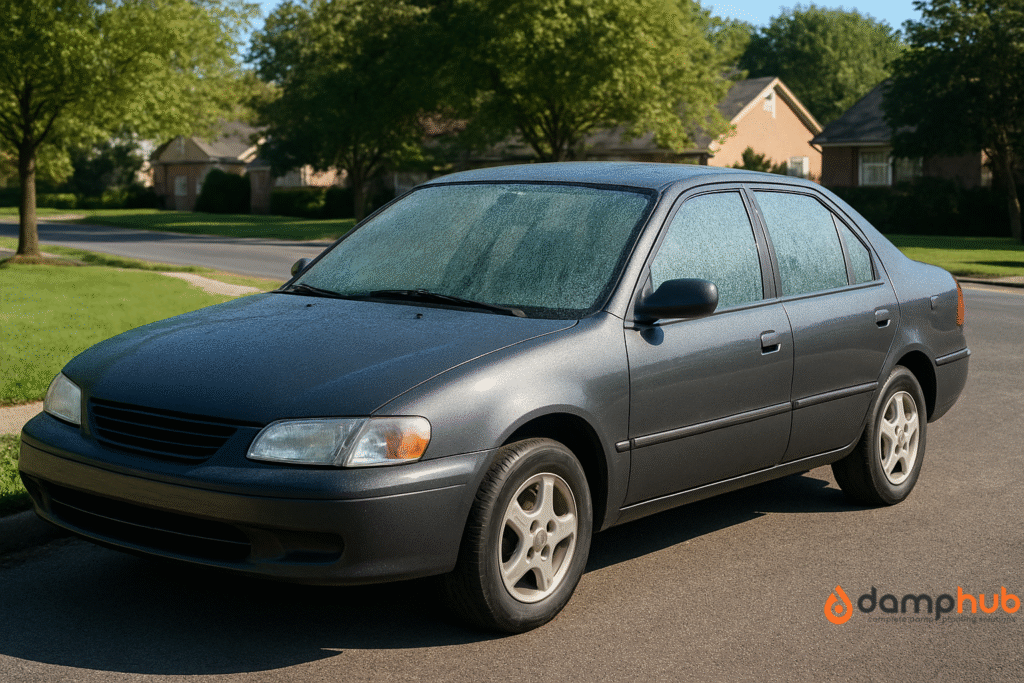
You slide behind the wheel on a cold morning, coffee in one hand, keys in the other. Instead of a quick getaway, you’re staring at a windscreen blurred with fog. You swipe at it with your sleeve, blast the heater, maybe even curse under your breath, yet it still takes forever to clear. That’s how condensation in car occurs.
The good news is you can stay ahead of it. Let’s break down why condensation happens, the early warning signs to watch for, and most importantly, how to stop condensation in a car so your mornings stay clear and stress-free.
What Is Condensation In A Car?
Condensation in a car happens when warm, moist air meets a cooler surface, like the inside of your windscreen. The water vapour in the air turns into droplets, creating that misty layer that blurs your view. It’s the same effect you see on bathroom mirrors after a hot shower, just less relaxing and more inconvenient.
Cars are particularly prone to this because they’re closed spaces. Every time you breathe, carry wet clothes, or bring in damp items (umbrellas, muddy boots, even your dog’s soggy fur), moisture builds up inside. Combine that with cold glass surfaces, and boom — fogged-up windows.
Causes Of Condensation In a Car
There isn’t just one culprit. Usually, it’s a mix of things:
- Damp items inside the car: That forgotten gym kit or wet floor mats from rainy days act like mini humidifiers.
- Temperature changes: Cold nights followed by you jumping in with warm breath are a recipe for fog.
- Poor ventilation: Blocked air vents or not using the AC properly means moisture has nowhere to escape.
- Clogged filters: A dirty pollen filter can trap dampness and slow airflow, leaving the car more humid than it should be.
If you’ve ever wondered why some mornings the car clears quickly and other times it feels impossible, chances are one of these factors is playing a bigger role than usual.
How Do You Spot Condensation In A Car?
Sometimes it’s obvious, sometimes it creeps up quietly. Here are the main giveaways:
- Misted windscreen: The most common and the most dangerous if you try to drive off too soon.
- Fogged lights: Headlights and taillights can mist up inside, dulling brightness and making you harder to spot on the road.
- Damp boot: Lifting the carpet and finding moisture or a musty smell is a red flag.
- Musty smell inside: Even when the windows look fine, a stale, damp smell usually means moisture is hanging around where it shouldn’t.
If you notice more than one of these, it’s a sign your car has a serious condensation problem, not just a one-off morning fog.
How To Stop Condensation In Car
Right, onto the fixes. Stopping condensation isn’t about one magic trick — it’s about reducing the sources of moisture and improving airflow. Here are the best approaches:
- Use your air conditioning, even in winter: It doesn’t just cool air; it dries it.
- Dry mats and seats: Shake out mats regularly and blot spills quickly.
- Try dehumidifier bags: These little pouches sit in your car and soak up excess moisture quietly.
- Check seals and filters: Make sure no rainwater is sneaking in and that your pollen filter is fresh.
Now, let’s break down some specific problem areas, because condensation doesn’t just attack your windscreen.

How to Stop Condensation Inside Car
Condensation inside car interiors is frustrating and sometimes dangerous if it clouds your view. It’s especially common when parked overnight or in cold weather. The good news is that there are simple steps you can take to get rid of it quickly.
- Remove damp sources: Condensation inside car when parked often builds because of wet mats, clothes, or umbrellas left behind. Take them out so moisture doesn’t linger.
- Dry mats and seats: Condensation inside car overnight usually comes from fabrics acting like sponges. Shake mats out and blot seats after spills.
- Check seals and drains: If you constantly battle condensation inside car windows, inspect door rubbers and drainage channels for leaks.
- Use heater and AC together: The fastest way to get rid of condensation inside car windows is by running warm air and AC at the same time. It clears the mist in minutes.
- Clean glass properly: If you’re wondering how to get rid of condensation inside car windshield, keep the inside glass streak-free — dirt makes moisture cling more.
- Replace clogged pollen filters: Poor airflow traps damp air, making condensation worse.
- Add a moisture absorber: Small dehumidifier bags help reduce condensation inside car interiors, especially when parked for days.
By combining these fixes, you’ll spend less time wiping misted glass and more time driving with a clear, safe view.
How To Stop Condensation In Car Windscreen
This is the most urgent one because it affects safety. Always start by:
- Turning on your air con with the heater.
- Pointing the blowers at the glass.
- Cracking the windows slightly if you’ve got a lot of moisture to shift.
And don’t wipe the inside with a sleeve or cloth if you can help it — it just smears oils and makes it worse next time.
You may also want to read: How to Stop Condensation on Windows Overnight
Pro Tip
If you want the quickest way to clear condensation in car, use both heat and AC at the same time. It warms the air while removing moisture, giving you a clear screen faster than heat alone.
How To Stop Condensation In Car Headlights
Moisture in headlights is common, especially after heavy rain or if seals are wearing out. If you notice fog inside the light casing:
- Remove the headlight unit if possible.
- Let it dry in a warm, ventilated space.
- Check and reseal any damaged rubber gaskets.
Driving with fogged lights isn’t just annoying — it reduces visibility and can even fail an MOT.
How To Stop Condensation In Car Lights
Rear lights and indicators can fog up if moisture sneaks in through a crack or weak seal. Once trapped, it clings to the cooler plastic and causes misting. To fix:
- Replace the unit if condensation keeps returning, as the casing may be too damaged.
- Remove the light unit from inside the boot where possible.
- Dry it fully in a warm, ventilated space or near a high-quality dehumidifier.
- Inspect the rubber seals and replace them if they look cracked or worn.
- Apply automotive sealant along edges or joins to block leaks.
How To Stop Condensation In Car Boot
A damp boot often comes from worn seals around the tailgate. The pooled water encourages mould and a stubborn musty smell. The best way to stop condensation in car boots is to:
- Lift the carpet and dry it thoroughly.
- Check seals with a torch to spot tiny gaps.
- Add a dehumidifier bag near the spare wheel well.
Also, dealing with condensation on your windows? Our other guide can help: How to Stop Condensation on Windows Overnight
Good To Know
A boot leak can sometimes track forward, causing bad condensation in car cabins, too. If you’ve been struggling with foggy windows for weeks, it’s worth checking the boot before blaming the heater.
How To Stop Condensation In Car Exhaust
A little water dripping from your exhaust is normal; it’s simply condensation formed during combustion. But excessive steam or constant pooling of water can point to other issues. Here’s what to look for:
- Normal drips after short trips are usually harmless.
- Excessive white steam could mean coolant is entering the system.
- Persistent water pooling under the car may indicate leaks or blockages.
- Check for rust spots as trapped moisture accelerates corrosion.
- Have a garage inspect it if the exhaust or catalytic converter seems unusually damp.
How To Stop Condensation When Sleeping In A Car
If you’ve ever camped in your car, you’ll know how quickly it fogs up overnight. Breathing alone adds a huge amount of moisture. To reduce condensation in car while sleeping:
- Crack the windows slightly, even in cold weather.
- Use a portable moisture absorber on the dash.
- Line windows with condensation pads or microfibre cloths before bed.
🛠️ Try This
Keep a small squeegee in your glovebox. In the morning, you can quickly clear condensation in car windows before the heater even kicks in. It sounds old-school, but it works a treat when you’re on the road.
Final Thoughts
Condensation in a car might feel like one of those problems you just have to put up with, but you don’t. By keeping the interior dry, checking seals, and using the ventilation properly, you can dramatically reduce condensation in car and avoid those foggy, stressful mornings.
The best way to stop condensation in a car is to stay on top of the little things: dry mats, a working pollen filter, and the occasional blast of AC. Ignore it, and you risk mould, smells, and even electrical damage. Stay proactive, and your windows will stay clear, your drives safer, and your mornings a lot less frustrating.
Answering Common Questions About Condensation In Cars

-
How Long Does Condensation Last In A Car?
It depends on the temperature difference and how damp the interior is. A mildly misted window might clear in five minutes with AC, while bad condensation in car interiors can take half an hour or more without proper ventilation.
-
How To Tell If Condensation Or Leak Car?
If you’re wiping windows every morning, but the carpets feel dry, it’s probably just condensation. But damp mats, dripping headliners, or water pooling under seats suggest a leak. In that case, fixing seals or drains is the only way to truly get rid of condensation in car long term.
-
Why Won’t The Condensation In My Car Go Away?
If the fog keeps coming back, something inside is staying wet — floor mats, seats, or even hidden areas under the dashboard. Replacing a blocked cabin filter often makes a big difference.
-
Does Air Conditioning Stop Condensation?
Yes. Air con works as a dehumidifier, pulling moisture out of the air. Even in winter, running the AC for a few minutes helps clear condensation in car much quicker.
-
Is It Normal For A Car To Drip Condensation?
Yes, from the exhaust it’s totally normal. From inside the cabin or light units, not so much. That’s when you need to dig deeper for leaks or blocked drainage.






